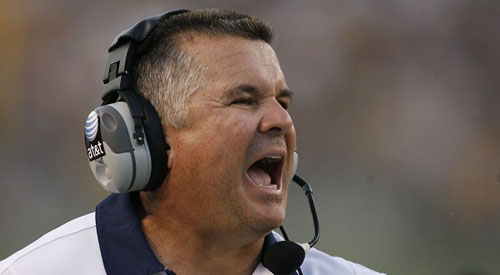
Loyalty, coaches, recruits and Todd Graham
One of this college football season’s strangest and most-maligned storylines involved Pitt head coach Todd Graham leaving his team before their bowl game, announcing his departure by text message and quickly taking a new job at Arizona State.
Plenty of coaches change teams each year, of course, but few do it after only one season in a job, and even less do so for what’s arguably a lateral move. Graham’s various explanations were rather unsatisfying, so that’s added to the popular disdain for him, and he’s been blasted as an example of coaches taking advantage of student-athletes. However, the real issue goes well beyond Graham or even football coaches in general. The state of college sports at a moment is that there isn’t a lot of room for loyalty on anyone’s part.
It’s easy to blast a coach like Graham for abandoning a program and there’s some rationale behind that. Players came to or stayed at Pitt because of Graham’s promises, so for him to abandon them after one year and to not even have the courtesy to tell them face to face certainly is worthy of some derision.
However, Graham’s far from the only coach to leave after a year (see Hugh Freeze, who jumped to Ole Miss after a single year as Arkansas State’s head coach, but has largely escaped criticism thanks to the new program’s higher profile), and it’s worth pointing out that athletic programs are often as duplicitous and disloyal. Sure, it would be great if coaches held up their end of the contracts they agreed to, but athletic departments often don’t; coaches can be fired for almost anything these days.
[php snippet=1]
Consider the case of Ralph Friedgen. The long-time Maryland coach led the Terrapins from 2001 to 2010, went 75-50 in that time and finished with a 9-4 2010 campaign that saw him named ACC coach of the year. Despite all his loyalty and success, the program promptly fired him (after earlier saying that he would be retained) and replaced him with Randy Edsall, who had just finished leading the University of Connecticut to a surprising BCS berth.
For their pains, the Terrapins promptly regressed to 2-10 in 2011. Friedgen’s case shows the perils of being a coach who isn’t always looking for the next career move. It’s not just long-time coaches who get canned either, as Turner Gill, Larry Porter and Rob Ianello were all fired this fall after just two seasons on the job.
It’s not just coaches and athletic programs that have significant loyalty issues these days, as the same problems extend all the way down the line to players. Plenty of players have gone back on their verbal “commitments,” choosing to attend another school at the last minute and screwing up coaches’ entire recruiting plans in the process. Others decide to transfer the minute they don’t get the playing time they want.
Of course, they’re not entirely at fault either, as many programs are extremely disloyal to players; see the debates around over-signing, gray shirting and releasing players thanks to phony medical issues, dubious practices favoured by many programs (including the BCS champion Alabama Crimson Tide). Just about everyone involved in college football is only looking out for themselves, and that appears to be the cost of doing business these days.
How can this be addressed? Well, solutions need to start at the players’ level, and some progress is being made on that front: rules have been brought in to curb over-signing and gray shirting, and others are being debated. One of the most promising moves from this corner is many Big Ten schools’ decisions to offer four-year scholarships to athletes, rather than the standard practice of renewable one-year scholarships that pave the way for schools to kick athletes to the curb when they’re no longer needed.
So far, the move hasn’t really helped with recruiting as many recruits probably have the deluded belief that things like dubious releases “will never happen to me,” but expanding that practice across the country could be a great start towards improving schools’ loyalty to players.
Improving players’ loyalty to schools is a more difficult proposition, but it might help if there’s more guaranteed for a player at the school they first “commit” to. For coaches, it could be possible to put in a minimum amount of time that they have to serve at a school, but the fear of condemnation of the sort Graham received might be enough on its own. For schools, probably the best tactic could be having alumni and donors encourage them to focus on loyalty, continuity and long-term success instead of instant success.
More loyalty would be nice to see, but it has to be a system-wide change. Otherwise, one group’s loyalty would only benefit the other groups, who could be as disloyal as ever.
A trend toward increased loyalty isn’t going to be a particularly easy change or a particularly quick one, either. Still, it’s worth pointing out that cases like Graham’s are only the tip of the iceberg, and only one part of a problematic system.
If Graham’s decision is worthy of condemnation, and there’s a good case to be made that it is, the wider system should be looked at. The current state of college football favours everyone looking out for their own interests; if we’d like to see increased loyalty, the change has to cover the whole system and reward athletes, coaches and programs for sticking with each other. Otherwise, we’ll continue to get more people acting like Todd Graham.
[php snippet=1]

